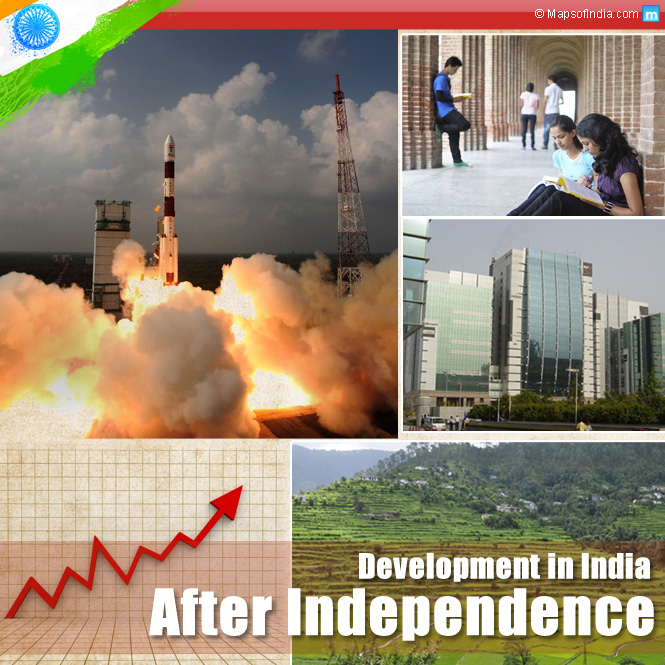India, which has now become an impactful country globally has grown a lot since it got its independence from colonial rule. But just like everything else, different people have different opinions about it. While some think that it has witnessed immense growth, others are of the view that the growth is slow as compared to what it should be.
Despite these contrasting views, the fact that remains is that the India we see today is different than what it was during independence. It has developed in terms of infrastructure, education, healthcare, science and technology, and in almost all other sectors. But still, it is considered a developing nation. This implies that the country is taking its own sweet time to catch up with the developed world.
Let us now look at the developments that India has made in different sectors in the past seven decades:
The Two Phases of Economy
An independent India was bequeathed a shattered economy, widespread illiteracy, and shocking poverty.
Contemporary economists divide the history of India’s economic growth into two phases – the first 45 years after independence and almost three decades of the free market economy. The years preceding the economic liberalisation were mainly marked by instances wherein economic development got stagnated due to a lack of meaningful policies.
The economic reforms came to India’s rescue with the launching of a policy of liberalisation and privatisation. A flexible industrial licensing policy and a relaxed FDI policy started getting positive responses from international investors. Among the major factors that drove India’s economic growth following the economic reforms of 1991 were increased FDI, adoption of information technology, and increased domestic consumption.
According to a report by International Monetary Fund (IMF), India has become the fastest growing economy in the world with a projected Gross Domestic Product (GDP) growth of 8.2% for FY2022.
Service Sector Growth
A major development in the nation’s services sector has been visible in the telecom and information technology sectors. A trend that started some two decades back is now well in its prime. Several multinational firms continue to outsource their tele services and IT services to India, resulting in the growth of ITES, BPO, and KPO companies. The acquisition of expertise in information technology has led to the generation of thousands of new jobs, which in turn increased domestic consumption, and naturally, more foreign direct investments happened to meet the demands.
Presently, the services sector employs more than 30% of the Indian workforce and this process of development started back in the 1980s. In the 60s, the sector employed only 4.5% of the working population. According to the Economic Survey 2021-22, the services sector accounted for more than 50% of Indian GDP, and the figures are expected to grow in the future.
Growth of the Agriculture Sector
Since the 1950s, the progress in agriculture has been somewhat steady. The sector grew at about 1 percent per annum in the first half of the 20th century. During the post-Independence era, the growth rate nudged about 2.6 percent per annum. Expansion of farming areas and the introduction of high-yielding varieties of crops were the major factors of growth in agricultural production. The sector could manage to end its dependency on imported food grains. It has progressed both in terms of yield and structural changes.
Consistent investment in research, land reforms, expansion of scope for credit facilities, and improvement in rural infrastructure were some other determining factors that brought about an agricultural revolution in the country. The country has also grown strong in the agri-biotech sector. The Rabobank report reveals that the agri-biotech sector has been growing at 30 percent in the past few years. The country is also likely to become a major producer of genetically modified/engineered crops.
Infrastructure Development
The Indian road network has become one of the largest in the world with the total road length increasing from 0.399 million km in 1951 to 4.70 million km as of 2015. Moreover, the total length of the country’s national highways has increased from 24,000 km (1947-69) to 1,37,625 km (2021). Governmental efforts have led to the expansion of the network of State highways and major district roads, which in turn has directly contributed to industrial growth.
As India needs power to drive its growth engine, it has triggered a noteworthy improvement in the availability of energy by adopting a multi-pronged approach. After almost seven decades of Independence, India has emerged as the third largest producer of electricity in Asia. It has increased its electricity generation capacity from 1,362 MW in 1947 to 3,95,600 MW as of 2022. Overall, power generation in India has increased from 301 billion units (BUs) during 1992- 93 to 400990.23 MW in 2022. When it comes to rural electrification, the Indian government has managed to bring lights to all 18,452 villages by April 28, 2018, as compared to 3061 in 1950.
Progress in Education Sector
Pulling itself out from widespread illiteracy, India has managed to bring its education system at par with the global standard. The number of schools witnessed a dramatic increase during the post-independence era. The Parliament made elementary education a fundamental right for children in the age group of 6-14 years by passing the 86th amendment to the Constitution in 2002. At independence, India’s literacy rate was a paltry 12.2 % which increased to 74.04% as per the 2011 census.
The Government launched the Sarva Siksha Abhiyan in 2001 to ensure education for children from 6 to 14 years. Prior to that, it had launched an effective initiative – Sponsored District Education Programme, which increased the number of schools across the country. In a bid to attract children to schools, especially in the rural areas, the government also started implementing the mid-day meals programme in 1995.
Achievements in the Field of Healthcare
A decrease in death rates is considered one of the major achievements that came India’s way in this sector. While life expectancy was around 37 years in 1951, it almost doubled to 65 years by 2011. In 2022, it was increased to 70.19 years. Similar improvement was noticed in the maternal mortality rate also. India’s maternal mortality rate also declined from 212 deaths per 100,000 live births in 2007 to 103 deaths in 2017-19, as per a report by The Hindu.
After a long-drawn struggle, India has been finally declared a polio-free country in 2014. The Swachh Bharat Abhiyan has provided an impetus to stop open defecation and prevent the spread of communicable diseases. Mortality in children under five years (per thousand live births) came down to 34 in 2019 from 126 in 1990. The government’s efforts yielded further results as the number of tuberculosis and HIV cases are also witnessing a declining trend (211 per 100,000 in 2016) as per WHO. Moreover, India has pledged to eradicate TB by 2025. The expenditure on public health has increased from ₹2.73 Lakh crore in 2019-20 to ₹4.72 Lakh crore in 2021-22. In 2018, the Central Government also launched the Ayushman Bharat Scheme which is a centrally funded health insurance scheme covering around 40% of the country’s population. Till now, it has issued over 12.5 crore Ayushman cards, and 1.23 crore people have availed its benefit.
Another big achievement in the healthcare sector is the making of COVID19 vaccines that helped the nation in fighting the deadly coronavirus.
Scientific Achievements
Independent India has taken confident strides on its road to scientific development. Its prowess is being manifested in a gradual scaling up of ambitious projects. India takes pride in its space programmes, which began with the launch of its first satellite Aryabhatta in 1975. Since then, India has emerged as a space power that has successfully launched foreign satellites. Through Chandrayaan-1, India became the 4th country in the world to plant its flag on the lunar surface in 2008. Its first mission to Mars was launched in November 2013 which successfully reached the planet’s orbit on 24 September 2014. In June 2015, ISRO launched 104 satellites (highest in the world) from a single rocket through PSLV-C37.
India is also aggressively pursuing both nuclear and missile programmes. That has simultaneously augmented the country’s defence strength as well. BrahMos inducted into the defence system is the world’s fastest cruise missile that has been jointly developed by India and Russia. After more than six decades of independence, India has now come closer to being an independent force to reckon with in the field of nuclear and missile technology.
Read Also:
Independence Day Speech Ideas for Students, Children, Teachers
70th Independence Day of India
69th Independence Day of India
About Independence Day
National Song of India
National Anthem of India
National Symbols of India
Nehru’s Message to Nation
15th August 1947: India after Partition is declared Independent of British Rule
26 January was Declared as Purna Swaraj Day
July 18th 1947: The India Independence Act 1947 Comes into Force
Unsung Heroes of Indian Independence
Pre-Partition Map of India
National Anthem controversy
Freedom Fighters of India
Skill development in India
NGOs and Rural Development in India
Sustainable Development Education in Schools
Disguised Unemployment in India





